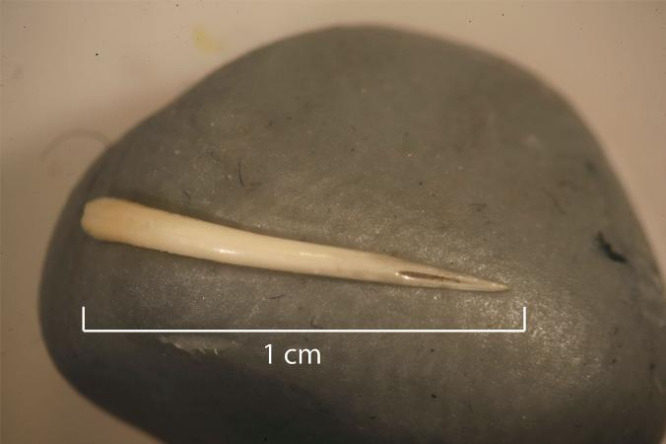
Photograph courtesy Elanor Sonderman Culture & History 1,500 years ago, someone ate a venomous snake whole. Why? Is the puzzling find evidence of an ancient ritual, or just a prehistoric dare gone wrong?
Analyzing coprolites-the preserved poop of people-is dirty, stinky work. But every once in a while, it reveals something truly surprising.
In the case of a new paper in the Journal of Archaeological Science, that startling something was the fang of a venomous snake, digested by a person and left in a rock shelter in what is now Texas about 1,500 years ago.
Archaeologist Elanor Sonderman, who found the fang as part of her graduate work at Texas A&M University, wasn't looking for that particular needle in a haystack of prehistoric feces. Rather, she wanted to learn more about the indigenous people who used the Conejo Shelter, a cave in the Lower Pecos canyonlands of Texas, as a latrine. The shelter became an archaeological dig in the 1960s before a dam project inundated the area with water.
Caves in this area held plenty of remarkably preserved ancient artifacts, including sandals and baskets woven from plant fiber, but the most valuable scientific data may come as a surprise to non-archaeologists.
"It's the poop," says Tim Riley, a coprolite expert and curator of Utah State University Eastern's Prehistoric Museum who was not involved with the research. Coprolites, Riley explains, contain a wealth of information: They can reveal more about the health of the person who deposited them, and the food remnants inside are direct evidence of what ancient peoples ate.
Analysis of the Conejo Shelter coprolite revealed pollen that indicated the person had consumed succulents like yucca flowers. The person had also eaten what appeared to be a small rodent without skinning or cooking-par for the course for people in the Lower Pecos at the time.

The fang's hollow center helped the team ID the unlucky snake as a member of the Viperidae family-most likely a Western diamondback rattlesnake or copperhead, both of which are common in the region. There weren't any char marks on the scales, which suggest it was eaten without cooking. And the sheer number of scales suggests the animal was eaten whole.
But why? It's impossible to go back in time and ask the coprolite creator, so the researchers delved into the history and mythologies of other cultures of the area for clues. They found that snakes were rarely consumed except in cases of dietary stress-and even then, they were usually prepared and cooked without bones, heads, or fangs. And even though snake remains have been found in other coprolites from Conejo Shelter, none of them seem to have come from a venomous species.
Rock art from the same region and time features snake-like motifs, and snakes played an important role as a gatekeeper to supernatural realms in shamanic rituals of other cultures of Mesoamerica and the American Southwest. A leading expert in rock art of the Lower Pecos, Carolyn E. Boyd, has suggested that the art could represent visions common to those who have consumed peyote and other mind-altering substances.
So is the fang evidence of a shamanic ritual? Though Sonderman's research team proposes that the snake was eaten for "a distinctly ceremonial or ritualistic purpose," there's no way to tell for sure. "I wouldn't want anyone to say 'We have a snake worshipping culture where people consume snakes ritualistically,'" says Sonderman. "That's not what we're trying to say. It's only one example."
What the fang does suggest, she says, is that it wasn't unheard of for people to eat venomous snakes-but, given its uniqueness, it could have been consumed on a special occasion. Or not. Maybe it was just a dare-or a very dangerous dietary preference.




R.C.